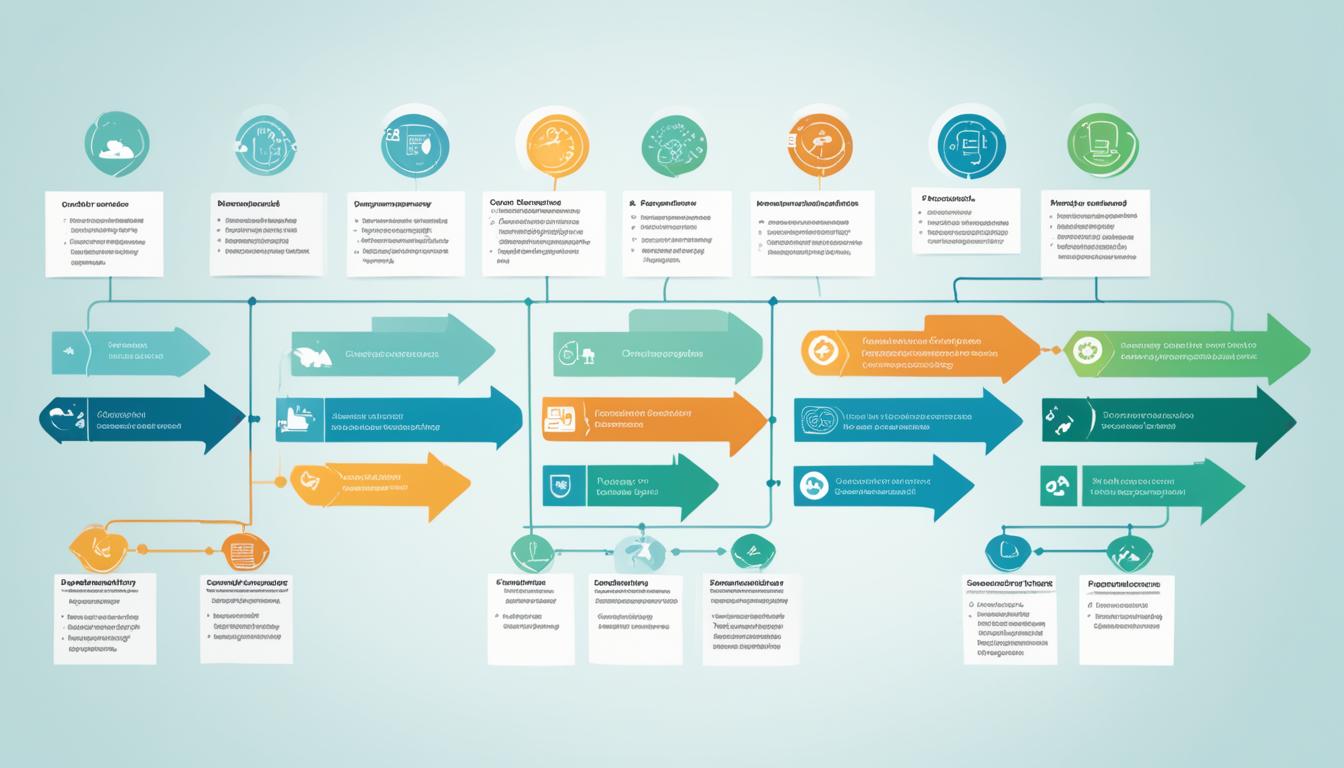A project stakeholder management plan is a crucial strategy document that ensures thorough engagement and effective communication with stakeholders throughout the project lifecycle. It outlines how the project team plans to manage the goals and expectations of key stakeholders. Stakeholders are individuals or groups who are impacted by the project or have a business interest in its outcome. They can include project team members, sponsors, executives, clients, end-product users, suppliers, contractors, and community members.
Prioritizing stakeholders, understanding their expectations, defining communication rules, and developing action plans are key components of an effective stakeholder management plan.
A well-crafted stakeholder management plan is essential for project success. It ensures thorough engagement and effective communication with stakeholders, which helps to align goals, manage expectations, and address conflicts. By prioritizing stakeholders, understanding their expectations, and developing communication rules and action plans, project managers can effectively manage stakeholder involvement and ensure project success.
Regularly updating the plan, maintaining transparency, and proactively addressing conflicts are key to effective stakeholder management. Creating a stakeholder management plan with the help of templates and following best practices will increase the chances of project success and stakeholder satisfaction.
Who Creates a Stakeholder Management Plan?
The stakeholder management plan is typically created by the project manager, who takes on the responsibility of ensuring effective stakeholder engagement throughout the project. However, it is important to involve input from everyone involved in the project to identify key stakeholders, assess their needs and expectations, and determine their level of influence.
Key stakeholders are individuals or groups who not only have an interest in the project outcome but also possess the power to influence communication plans and other project procedures. This includes clients, project team members, sponsors, resource managers, and executive committee members. It is crucial to consider the perspectives and insights of these key stakeholders as they play a vital role in shaping the project’s success.
Collaboration and inclusivity in the stakeholder management planning process ensure that the plan accurately reflects the needs and expectations of all relevant parties. By involving key stakeholders from the outset, the project manager establishes a strong foundation for effective stakeholder engagement and ensures that the stakeholder management plan is well-aligned with the project objectives.

What is Covered in a Stakeholder Management Plan?
A stakeholder management plan encompasses various crucial components to ensure effective stakeholder engagement and communication throughout the project. These components include:
- Prioritization of Stakeholders: Stakeholders are prioritized based on their level of influence over the project and their interest in its outcome. This helps in identifying key stakeholders who require special attention and consideration.
- Stakeholder Expectations: The plan documents stakeholder expectations, including their preferred communication methods and desired level of involvement. Understanding these expectations facilitates tailored communication strategies and engagement approaches.
- Communication Rules: The plan outlines communication rules specific to each stakeholder. It specifies the frequency, type, and level of communication required for effective engagement. Additionally, it identifies the point of contact on the project team, ensuring clear lines of communication.
- Action Plans: Action plans are developed to effectively manage stakeholder involvement and ensure that their expectations are met. These plans outline the steps to be taken to engage stakeholders and address their needs throughout the project lifecycle.
A stakeholder management plan plays a vital role in fostering positive stakeholder relationships and mitigating potential conflicts. By encompassing these key components, the plan ensures that stakeholders are engaged, their expectations are understood, and effective communication strategies are implemented.

Additional Considerations
While the aforementioned components form the core of a stakeholder management plan, it is also essential to evaluate and monitor the plan’s effectiveness throughout the project lifecycle. Regular reviews should be conducted to assess stakeholder satisfaction, adapt communication strategies as needed, and proactively address any emerging issues or concerns.
Furthermore, stakeholder management should be approached with a mindset of continuous improvement. Feedback from stakeholders should be actively sought and incorporated into future iterations of the stakeholder management plan.
By implementing a comprehensive stakeholder management plan, project teams can foster strong stakeholder relationships, ensure alignment with stakeholder expectations, and increase the chances of project success.
| Benefits of a Stakeholder Management Plan | Challenges Addressed |
|---|---|
| Improved stakeholder engagement | Lack of stakeholder involvement |
| Enhanced understanding of stakeholder expectations | Unclear or misaligned stakeholder expectations |
| Effective communication strategies | Inconsistent or inadequate communication with stakeholders |
| Proactive management of stakeholder needs | Unaddressed stakeholder concerns |
Why is a Stakeholder Management Plan Important?
A stakeholder management plan is crucial for the success of a project. Key stakeholders play a significant role in project outcomes and have the potential to impact its success. By developing a well-documented stakeholder management plan, project teams can ensure that stakeholder interests and expectations are understood and effectively addressed. This plan acts as a guiding framework for communication and engagement, benefiting the project as a whole.
Effective communication with stakeholders is paramount to project success. A stakeholder management plan outlines the communication channels and strategies that will be utilized to engage with stakeholders throughout the project lifecycle. By proactively addressing stakeholder needs, concerns, and expectations, project teams can build trust and maintain positive relationships. This, in turn, promotes stakeholder buy-in and support, significantly increasing the likelihood of project success.
“A stakeholder management plan allows for proactive identification and understanding of stakeholder needs, interests, and expectations, enabling project teams to tailor their approaches accordingly.”
Furthermore, a stakeholder management plan assists in anticipating stakeholder needs and aligning project objectives with their priorities. By conducting stakeholder analysis, teams can identify the various stakeholder groups, their specific interests, and potential areas of conflict. This analysis helps project teams to better understand stakeholder motivations and adapt project approaches to meet their requirements, mitigating potential roadblocks and maximizing stakeholder satisfaction.
Without a stakeholder management plan, projects can encounter challenges such as disengaged or actively resistant stakeholders. This can lead to delays, miscommunications, and a lack of stakeholder support, ultimately jeopardizing project success. By proactively involving stakeholders, addressing their needs, and leveraging stakeholder analysis, project teams can minimize these risks and foster an environment that promotes stakeholder collaboration and commitment.

Top Tips for Creating a Stakeholder Management Plan
Creating an effective stakeholder management plan is crucial for project success. By prioritizing stakeholders and establishing clear communication channels, you can ensure that everyone is aligned, informed, and engaged throughout the project lifecycle. Here are some top tips to help you create a robust stakeholder management plan:
1. Use a Template or Pre-Built Guide
Save time and ensure consistency by using a template or pre-built guide for your stakeholder management plan. Templates provide a framework that covers essential elements, allowing you to focus on tailoring it to your specific project.
2. Start Involving Stakeholders Early
Engaging stakeholders early in the project allows you to identify their needs, expectations, and concerns. This early involvement fosters a sense of ownership and increases stakeholder engagement, setting the stage for a successful outcome.
3. Regularly Update the Plan
A stakeholder management plan should not be static. Regularly updating the plan to reflect changes in stakeholders and their needs ensures that you stay aligned and in sync with their expectations. This flexibility and responsiveness will help you adapt to evolving circumstances and maintain stakeholder satisfaction.
4. Maintain Transparency
Transparency is key to building trust and cooperation among stakeholders. Sharing project updates, progress, and challenges openly ensures that stakeholders are well-informed and feel included in the decision-making process. This transparency fosters collaboration and mitigates the risk of misunderstandings or hidden agendas.
5. Prioritize Stakeholders Based on Influence and Interests
One of the most critical aspects of stakeholder management is prioritizing your stakeholders. Prioritization should be based on their influence and interests. Identifying influential stakeholders and understanding their expectations allows you to allocate resources effectively and tailor your communication efforts to build strong relationships with key players.
6. Keep the Plan Concise and Easy to Understand
A stakeholder management plan should be concise and accessible to all readers. Avoid unnecessary jargon and complexity. Keep the plan concise and focus on clarity to ensure that stakeholders easily comprehend their roles, responsibilities, and the overall project objectives.
7. Plan for Conflict Resolution
Conflicts are bound to arise during a project. Anticipating potential conflicts and having a plan for conflict resolution in place will help you address disagreements promptly and effectively. By addressing conflicts head-on, you can minimize disruptions and maintain stakeholder relationships.
8. Publish the Stakeholder Management Plan
To increase transparency and prevent oversight, consider publishing your stakeholder management plan. Making the plan accessible to all stakeholders and relevant parties fosters accountability, enables efficient decision-making, and ensures that everyone is on the same page.
By implementing these top tips, you can create a comprehensive stakeholder management plan that optimizes stakeholder engagement, communication, and collaboration. This proactive approach will significantly contribute to the success of your project and help you build strong stakeholder relationships.
Conclusion
Creating a well-crafted stakeholder management plan is crucial for project success. It enables thorough stakeholder engagement and fosters effective communication, which in turn helps to align project goals, manage expectations, and address conflicts. By prioritizing stakeholders, understanding their expectations, and developing clear communication rules and action plans, project managers can effectively manage stakeholder involvement and drive project success.
Regularly updating the stakeholder management plan, maintaining transparency, and proactively addressing conflicts are key practices for effective stakeholder management. By embracing these strategies, project managers can adapt to changing stakeholder dynamics, build trust, and foster collaboration. Additionally, utilizing templates and best practices when creating the stakeholder management plan increases the chances of project success and ultimately satisfies stakeholder needs and expectations.
In summary, a well-executed stakeholder management plan is an indispensable tool for project success. It ensures comprehensive stakeholder engagement, facilitates effective communication, and enhances the overall project outcome. Adopting a strategic approach to stakeholder management, marked by regular updates, transparency, and proactive conflict resolution, empowers project managers to navigate challenges successfully and deliver results that meet both project objectives and stakeholder satisfaction.




